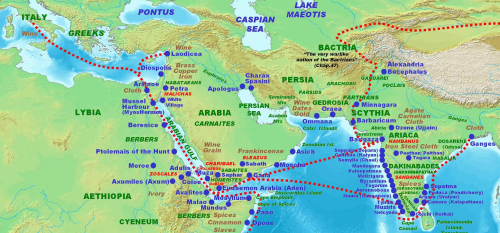 |
| Names, routes and locations of the Periplus of the Erythraean Sea. |
Classic Italian wine amphora, which came from Naples and belonged to the late first century B.C have been been found in a number of Roman sites in India, including Arikamedu and Alagankulam in Tamil Nadu. Bright red Samian ware from Arezzo near Tuscany have also reached Arikamedu near Pondicherry. A new study says that some of the artifacts thought to be Roman were actually from Mesopotamia.
More than 10,000 Roman coins are known from southern India alone, and although
there are growing numbers of amphorae reported, identification is more
problematic, Tomber says. Her survey has confirmed the presence of such wine
jars from 31 sites, but at about half these sites it was also discovered
that amphora sherds thought to be Roman were actually Mesopotamian in
origin.In ten cases there were only Mesopotamian sherds present. These were in the
form of “torpedo jars”, tall cylindrical peg-footed amphorae, common in
Mesopotamia and the Gulf but not hitherto noted in India. Fragments of the
rims and bodies could be mistaken for Roman wares made in Syria and
Anatolia, as indeed they have been, and their dates span the Roman period
from around the time of Christ onwards, although they also continue into
early Islamic times in the seventh century.The port of Qana, on the coast of Yemen and an important point in the
frankincense trade, may have been an entrepôt for both Roman and
Mesopotamian goods arriving from the Red Sea and the Persian Gulf
respectively. It has not yielded the full range of Late Roman amphorae found
in India, however, and other places may have played an equal role. The
overall distribution of Roman amphorae and torpedo jars suggests three
seaborne routes to India, Dr Tomber proposes. One ran direct from the Gulf,
one direct from ports such as Berenike on the Red Sea coast of Egypt, and
one via Qana.[Mesopotamia was a vital link on Roman-Indian trade routes]